| |
 Sled Dog team Sled Dog team
Imagine running a race course over 1,000 miles long! In bad weather! The best athletes can cover it in just over nine days; the slower ones may take over two weeks. But no human could ever run this race. Humans cannot sustain such a high level of exercise for more than a few days. Even the best human long-distance runners must recover for several days after a race. After such prolonged periods of exercise, all of the bodyís energy reserves are used up.
Energy in the body is stored primarily in muscle cells in the form of glycogen. A glycogen molecule is one long chain of many smaller glucose molecules. As all What A Year! regulars know, glucose is a simple sugar and one of the most basic components in the food you eat. It is used immediately by cells to create energy through the process called cellular respiration. Any excess glucose that you canít use immediately is converted into glycogen and stored in your muscle cells. Those muscle cells themselves have a maximum capacity for storing glycogen, and once that limit is reached, any glucose remaining in the bloodstream is converted to fat. When humans exercise, we take energy that already exists in the body as glycogen and convert it to glucose. Once glycogen reserves have been used up, fatigue sets in and it is no longer possible to remain at the same performance level.
It would be impossible for a human to complete this 1,000-mile race, even if it were done in chunks, with plenty of recovery time. The race, known as the Iditarod, takes place every year between Willow and Nome, Alaska, where temperatures range from lows around -40 degrees F to highs in the mid-30 degrees F. It is run annually by teams composed of a (human) "musher" and 16 sled dogs. Unlike humans, these sled dogs are able to maintain a high level of exercise for over two weeks without experiencing fatigue. Dr. Mike Davis of Oklahoma State University wants to find out how.
Studying Hard Exercise Is Hard
Dr. Davis is a researcher and registered veterinarian interested in the physiology of strenuous exercise Ė in other words, how the cells, muscles, bones and organs of the body work during strenuous exercise.
Initially he studied exercise-induced asthma in animals exercising while breathing cold air. A dog model existed for such studies, but, interestingly, the experiments themselves did not include exercise! Dr. Davis needed a dog model for exercising dogs, and sled dogs were the best model for submaximal exercise such as hiking or cross-country running under the cold conditions he wanted to study. Traditional models of maximal exercise levels, such as sprinting or weigh lifting, are short-term and last from several minutes to several hours. The physiology of exercise at the maximal level is very different from that of exercise at the submaximal level. This is because different levels of exercise are limited by different factors.
Exercise at the maximal level, the 50-meter dash, for example, is limited by how fast the sprinterís muscles can contract. The exercise only lasts a few seconds and the winner will have been able to generate the most power in a split second. A cyclist out for several hours is no longer limited by muscle contraction speed, but by the cyclistís ability to deliver oxygen to the cells. This is determined by cardiovascular fitness and cardiovascular capacity.
Multi-day submaximal exercise, on the
other hand, is not limited by contraction speed or the ability to deliver
oxygen. Instead, it is limited by the ability of the body to deliver whatever
itís burning — fats and sugars — to the muscle cells.
Muscle cells have a certain amount of fat and glycogen
reserves that take time to build up. Once those reserves are depleted, humans
canít do anything else for the two to four days while they are replenished.
The ability to continue day after day is related to the ability to move nutrients
from the gastrointestinal tract through
the bloodstream and into the cells. Dr. Davis has shown through his experiments
that sled dogs are able to do this extremely efficiently.
Teams of Researchers Follow Teams of Sled Dogs 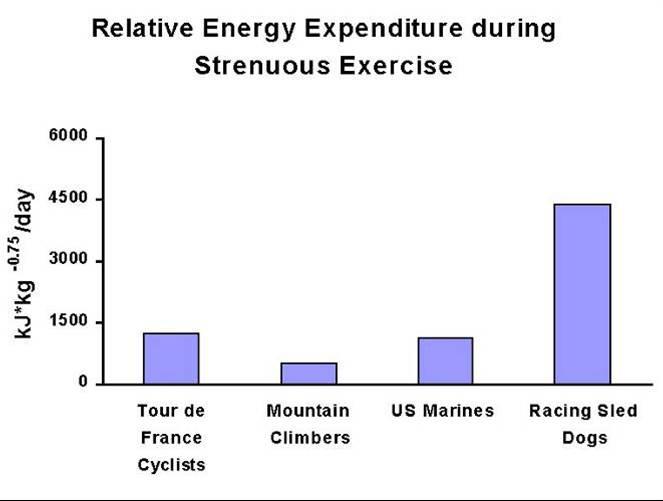
In a recent study, Dr. Davis followed three teams of sled dogs that ran 140 kilometers (about 87 miles) for four days in a row. The researchers took small samples of muscle tissue, called a muscle biopsy, from some of the dogs each day after racing and then after a recovery period. Six of the dogs were fit to race but were kept instead as controls to compare the results of the racing dogs to dogs that had not raced. So the researchers had muscle tissue from dogs that had run 0, 140, 280, 420, and 560 kilometers, samples taken immediately after they finished racing and samples taken many hours afterwards. The muscle tissue was tested for muscle glycogen levels. The researchers found that during the first day of racing, the sled dogs used a significant portion of their stored glycogen. On the last day of racing, though, the sled dogs had used only a small portion of their stored glycogen, even though they had completed the same amount of exercise. Based on this experiment, Dr. Davis concluded that the sled dogs must adapt to such strenuous levels of exercise so that they no longer rely on their stored glycogen.
In a previous set of experiments, he and his team took blood samples of dogs before, during, and after racing five consecutive days. The blood samples were tested for many components, including two important markers of tissue damage: creatine phosphokinase
(CPK) and cardiac troponin. When tissue cells die, their components are released into the blood stream, so high levels of these components indicate tissue damage. CPK is a marker for skeletal muscle cell damage and cardiac troponin indicates cardiac muscle cell damage. Dr. Davis found that CPK and cardiac troponin levels in the sled dogs were high after the first day of exercise, indicating significant tissue damage which would be expected from such strenuous exercise. After several days, though, these levels started to decrease as the dogs adapted to the high levels of exercise.
Fatigue, and Then No Fatigue
The experiments on muscle glycogen levels supported Dr. Davisís previous findings on CPK and cardiac troponin. After the first day of exercise, the dogs exhibited all the symptoms of strenuous exercise: fatigue, decreased glycogen reserves, and increased tissue damage. By the last days of the race, though, these symptoms had dissipated and the dogs were not experiencing fatigue. In fact, their glycogen reserves had increased, and the CPK and cardiac troponin levels were lower. With these changes the sled dogs were the same metabolically on the last day of racing as the first, except for the fact that they were burning 8,000 calories per day. "The sled dogsí ability to adapt is absolutely astonishing," remarked Dr. Davis. "We now know what theyíre doing. What we want to know is how."
A Little Cell Physiology
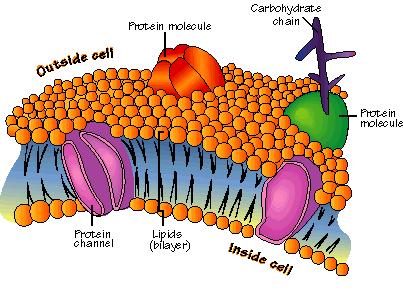 The crucial point lies at the cell membrane of muscle cells. This is because most molecules require a specific transporter to cross the cell membrane and enter cells, but these transporters are not always there. Normally transporters are inside the cell and only move towards the cell membrane when stimulated by certain conditions such as muscle contraction. If a muscle starts contracting, the transporters will move towards the cell membrane to enable more fuel to enter the cell. Another way transporters can be stimulated is through insulin-stimulation. An increased presence of insulin will draw transporters towards the cell membrane. Insulin-stimulation and contraction-stimulation are two distinct pathways that share a common part. Dr. Davis is investigating specific parts of these pathways in order to find out the mechanism(s) that enable the sled dogs to adapt so well. The crucial point lies at the cell membrane of muscle cells. This is because most molecules require a specific transporter to cross the cell membrane and enter cells, but these transporters are not always there. Normally transporters are inside the cell and only move towards the cell membrane when stimulated by certain conditions such as muscle contraction. If a muscle starts contracting, the transporters will move towards the cell membrane to enable more fuel to enter the cell. Another way transporters can be stimulated is through insulin-stimulation. An increased presence of insulin will draw transporters towards the cell membrane. Insulin-stimulation and contraction-stimulation are two distinct pathways that share a common part. Dr. Davis is investigating specific parts of these pathways in order to find out the mechanism(s) that enable the sled dogs to adapt so well.
Dr. Davis first focused on insulin-sensitivity. He and his team of researchers followed sled dogs on the trail. The sled dogs were given enough insulin to shut down their own insulin-producing pathways. Since the increase in insulin decreases blood glucose levels, the dogs were also given glucose. Dr. Davis and his team measured the dogsí blood glucose levels every five minutes to keep insulin and glucose levels in balance. When the glucose was balanced, the researchers knew how much glucose to give the dogs to maintain normal blood glucose levels. This amount of glucose is a measure of insulin sensitivity. The results of this experiment showed that the insulin sensitivity of sled dogs increased over time during the race.
Futures Ė For Animal and Human Health
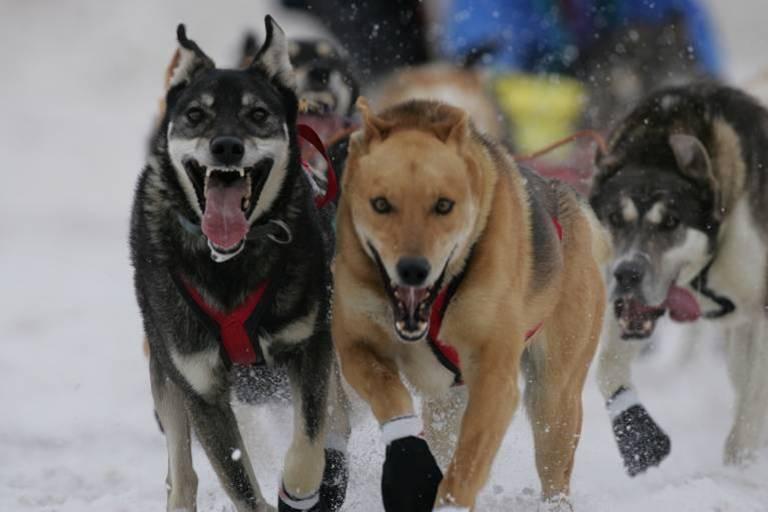 Dr. Davisís upcoming research will focus on the movement of large molecules such as glucose and fatty acids through the bloodstream. In one experiment, the dogs will be put on a treadmill so their glucose and fatty acid levels can be measured after already racing 400 miles. In another set of experiments, Dr. Davis will study transporters in muscle cells. The dogs will race and some dogs will be taken out every 100 miles for a muscle biopsy. The researchers will count the number of transporters on the cell membrane of the muscle cells to see how they change during different conditions. As a result of these experiments, Dr. Davis hopes to determine which transporters are increased and the overall effects of these transporters on the energy needs of sled dogs. He hopes that these experiments will point the researchers to a specific pathway that can be manipulated to determine the exact mechanism of the sled dogsí adaptation to strenuous exercise. Dr. Davisís upcoming research will focus on the movement of large molecules such as glucose and fatty acids through the bloodstream. In one experiment, the dogs will be put on a treadmill so their glucose and fatty acid levels can be measured after already racing 400 miles. In another set of experiments, Dr. Davis will study transporters in muscle cells. The dogs will race and some dogs will be taken out every 100 miles for a muscle biopsy. The researchers will count the number of transporters on the cell membrane of the muscle cells to see how they change during different conditions. As a result of these experiments, Dr. Davis hopes to determine which transporters are increased and the overall effects of these transporters on the energy needs of sled dogs. He hopes that these experiments will point the researchers to a specific pathway that can be manipulated to determine the exact mechanism of the sled dogsí adaptation to strenuous exercise.
This research has implications for human health. People with type 2 diabetes would benefit from increased insulin-sensitivity to help manage their disease. Elite athletes and soldiers could also benefit from increased contraction-sensitivity during multi-day exercise to improve their performance. Dr. Davis hopes that the adaptations found in sled dogs could address these situations. He also believes that sled dogs are not the only dogs or only species capable of such astonishing super-physiology. "It would not surprise me if some species of migratory birds were able to adapt in similar ways," he said. "For now, I love studying the sled dogs and canít believe itís actually my job."
Dr. Michael Davis is a Professor of Physiological Sciences at Oklahoma State University and a licensed veterinarian. He decided at a young age that he wanted to "fix broken animals for a living." Indeed, Dr. Davis went to veterinary school and spent many years as a veterinarian before deciding to go into research. He went back to school to study exercise physiology and has been studying sled dogs for the past decade. Dr. Davis loves the hands-on research he is able to do with sled dogs. "I canít imagine doing anything else."
For more information:
- McKenzie, E., et al. “Assessment of alterations in triglyceride and glycogen concentrations in muscle tissue of Alaskan sled dogs during repetitive prolonged exercise.” 2008. American Journal of Veterinary Research, 69(8): 1097-1103.
- McKenzie, E.et al. “Serum chemistry alterations in Alaskan sled dogs during five successive days of prolonged endurance exercise.” 2007. Journal of the American Veterinary Medical Association, 230(10): 1486-1492.
- Durocher, L.et al. “Effect of strenuous exercise on urine concentrations of homovanillic acid, cortisol, and vanillylmandelic acid in sled dogs.” American Journal of Veterinary Research, 68(1): 107-111.
To learn more:
Sled Dogs:
- Happy Trails Kennels owned by Martin Buser
http://www.buserdog.com
- Skunk's Place Kennels owned by Aliy Zirkle and Allen Moore
http://www.SPKDogLog.com
Written by Rebecca Kranz with Andrea
Gwosdow, Ph.D. Gwosdow
Associates
HOME | ABOUT | ARCHIVES | TEACHERS | LINKS | CONTACT
All content on this site is © Massachusetts
Society for Medical Research or others. Please read our copyright
statement — it is important. |
|
|

Dr. Mike Davis
Sign Up for our Monthly Announcement!
...or  subscribe to all of our stories! subscribe to all of our stories!

What A Year! is a project of the Massachusetts
Society for Medical Research.
For a short video of Dr. Davis describing his work, follow this link: http://www.the-aps.org/Video/Clips/michaeldavis.htm (Courtesy of the American Physiological Society)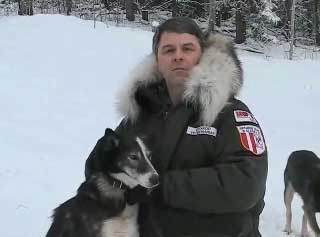
To see a keynote presentation for high school students and teachers in which Dr. Davis converts sled dog food usage to Big Mac units, follow this link and then open the PowerPoint file: http://www.the-aps.org/education/K12EBWorkshop.htm

Here, from YouTube, is a video that shows you what itís like to ride on a sled being pulled by dogs at 20 mph: 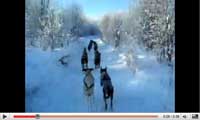
And here
is a video in which Dr. Davis explains in somewhat greater detail
the possible outcome of his research:
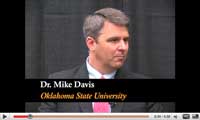
|
|

